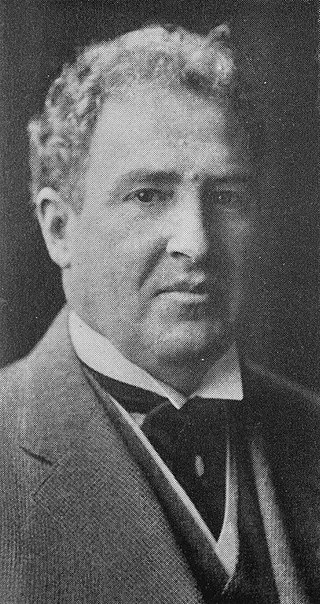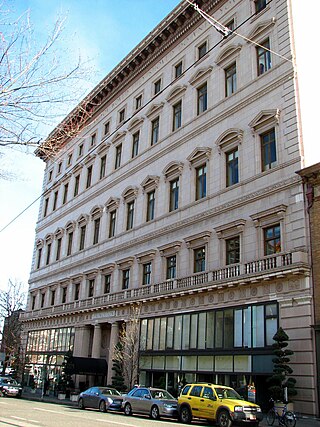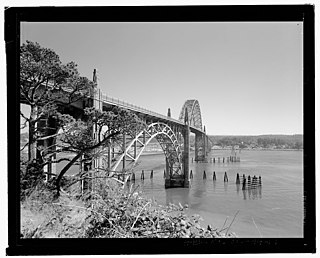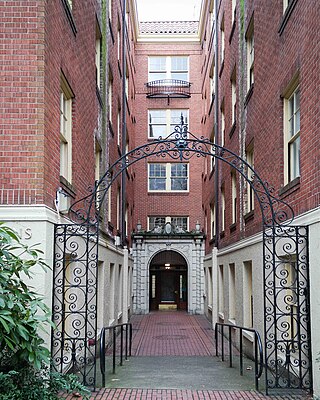
The Oregon Historical Society(OHS) is an organization that encourages and promotes the study and understanding of the history of the State of Oregon, within the broader context of U.S. history. Incorporated in 1898, the Society collects, preserves, and makes available materials of historical character and interest, and collaborates with other groups and individuals with similar aims. The society operates the Oregon History Center that includes the Oregon Historical Society Museum in downtown Portland.
Richard John Haas is an American muralist who is best known for architectural murals and his use of the trompe-l'œil style. Haas has a 1959 B.S. from the University of Wisconsin–Milwaukee and a 1964 M.F.A. from the University of Minnesota.

The Lloyd District is a primarily commercial neighborhood in the North and Northeast sections of Portland, Oregon, United States. It is named after Ralph Lloyd (1875–1953), a California rancher, oilman, and real estate developer who moved to and was an early commercial developer for the area in 1905.

The Oregon Historical Society Museum is a history museum housed at the Oregon Historical Society in downtown Portland, Oregon, United States. The museum was created in 1898 and receives about 44,000 visitors annually.

The Seward Hotel, also known as the Governor Hotel, is a historic hotel building in downtown Portland, Oregon, United States, that is listed on the National Register of Historic Places (NRHP). Built in 1909, it is one of two NRHP-listed buildings that make up the Sentinel Hotel, the other being the 1923-built Elks Temple. The Seward was renamed the Governor Hotel in 1931, closed in the mid-1980s, and reopened in 1992 joined with the former Elks building, and thereafter formed the east wing of a two-building hotel.

The Commodore Hotel is an Art Deco-style former hotel building in Portland, Oregon, United States. It was built in 1925 and designed by Herman Brookman. It was listed on the National Register of Historic Places in 1984.

John Virginius Bennes was an American architect who designed numerous buildings throughout the state of Oregon, particularly in Baker City and Portland. In Baker City he did an extensive redesign of the Geiser Grand Hotel, designed several homes, and a now-demolished Elks building. He moved to Portland in 1907 and continued practicing there until 1942.

The Admiral Apartments, originally the Wheeldon Apartments and also known as the Admiral Hotel Apartments, is a five-story brick Tudor Revival apartment building in downtown Portland, Oregon, United States, that was built in 1909. It has been on the National Register of Historic Places since 1990.

The Cornelius Hotel is a historic hotel building in downtown Portland, Oregon, United States that is listed on the National Register of Historic Places. It was designed by John V. Bennes's firm, and constructed in 1907–08. It ceased to be used as a hotel by the 1950s. A fire in 1985 left the top three floors of the structure uninhabitable. By the early 1990s, the building had been vacated, and it remained vacant for more than two decades. In 2016–2018, it was joined to the adjacent Woodlark Building, extensively renovated, and converted into a hotel. The Woodlark Hotel opened on December 15, 2018.

The Elks Temple, also known as the Princeton Building and as the west wing of the Sentinel hotel, is a former Elks building and historic hotel building in downtown Portland, Oregon, United States. Built in 1923, it is one of two NRHP-listed buildings that make up the Sentinel Hotel, the other being the 1909-built Seward Hotel. The Seward was renamed the Governor Hotel in 1932, and in 1992 it was joined with the former Elks building, and thereafter the building became the west wing of a two-building hotel, an expanded Governor Hotel. The hotel's main entrance was moved to this building from the east building in 2004. The Governor Hotel was renamed the Sentinel Hotel in 2014. Use of the building as an Elks temple lasted less than a decade, ending in 1932.

The Barber Block is a building complex located at the corner of Southeast Grand and Washington Streets in Portland, Oregon, listed on the National Register of Historic Places (NRHP). It was built in 1890 and listed on the NRHP in 1977. It is also located within the East Portland Grand Avenue Historic District.

The Jeanne Manor Apartment Building is a seven-story apartment hi-rise located in downtown Portland, Oregon, in the United States, listed on the National Register of Historic Places. Architects Bennes and Herzog finished the Art Deco structure in 1931. The Jeanne Manor faces the South Park Blocks at the corner of Southwest Park Avenue and Clay Street.

The Meier & Frank Delivery Depot, located in northwest Portland, Oregon, is listed on the National Register of Historic Places. Built for Portland retailing company Meier & Frank, the building was designed by Sutton & Whitney and constructed in 1927. From 1986 to 2001, the building was owned by the Oregon Historical Society, for processing of items and storage of its collections.

The John Jacob Astor Hotel, originally known as the Hotel Astoria, is a historic former hotel building located in Astoria, Oregon, United States, and listed on the National Register of Historic Places (NRHP). It is one of the tallest buildings on the Oregon Coast and is a "prominent landmark" in Astoria. Constructed in 1922–23, the hotel opened in 1924 and initially was the city's social and business hub, but soon was beset with a variety of problems, and struggled financially for years. It was renamed the John Jacob Astor Hotel in 1951, but a decline in business continued, as did other problems. The building was condemned by the city for safety violations in 1968 and sat vacant for several years until 1984, when work to renovate it and convert it for apartments began. It reopened as an apartment building in 1986, with the lowermost two floors reserved for commercial use. The building was listed on the NRHP in 1979. The world's first cable television system was set up in 1948 using an antenna on the roof of the Hotel Astoria.

The Merchant Hotel, also known as the Merchants' Hotel, is a historic former hotel building in Portland, Oregon, United States. It is located at 121 N.W. Second Avenue in Old Town Chinatown. It is a contributing property in the Portland Skidmore/Old Town Historic District, which was listed on the U.S. National Register of Historic Places in 1975 and designated a National Historic Landmark District in 1977. It is one of the few remaining examples of Victorian Italianate, cast iron architecture on the West Coast. It occupies half of a city block, specifically along the south side of N.W. Davis Street from Second to Third Avenues.

James Burton Norman Jr. is an American photographer, author, and cultural historian.

Blackstone Hall is a five-story student residence hall at Portland State University in Portland, Oregon, a city in the United States. The building contains five two-bedroom units, 19 one-bedroom units, 14 studios, and 13 sleepers that share a bath, shower, and kitchen.
Harry Mittleman was a prominent building contractor, apartment owner, and real estate developer in Portland, Oregon. During his career, he built more than 20 apartment buildings and owned 30 bank buildings. Mittleman owned the Sovereign Hotel for 34 years. The Mittleman Jewish Community Center at the Schnitzer Family Campus is named after Mittleman's wife, Helen Mittleman.

St. Helens Court is a five-story student residence hall at Portland State University in Portland, Oregon, a city in the United States. The building contains 36 studios and 15 one-bedroom units.

Oregon History, sometimes called the Oregon Historical Society mural, is a pair of eight-story-tall 1989–1990 trompe-l'œil murals by Richard Haas, installed outside the Oregon Historical Society, on two sides of the Sovereign Hotel building in Portland, Oregon, in the United States.






















